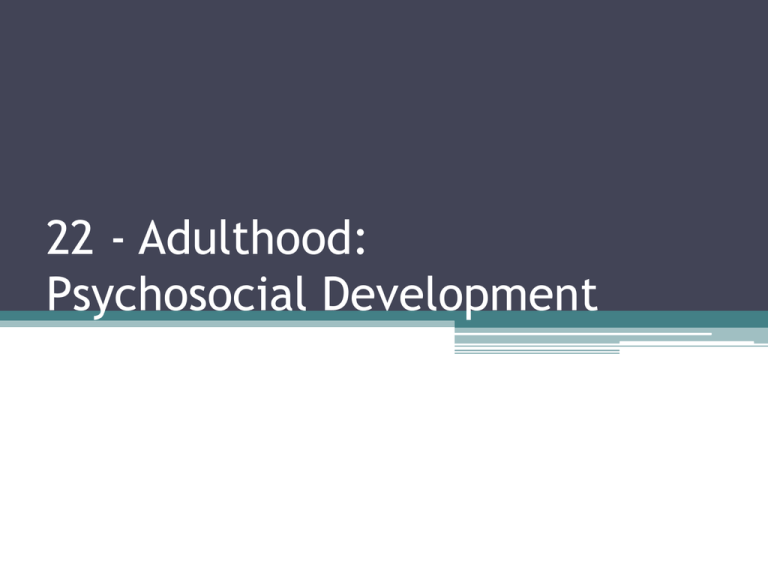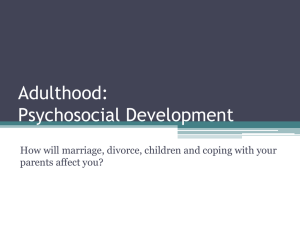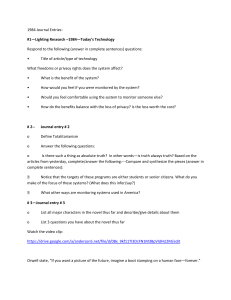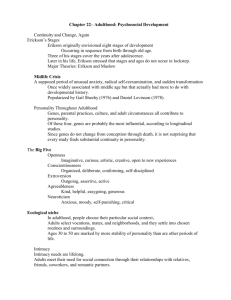22 - Adulthood: Psychosocial Development
advertisement

22 - Adulthood: Psychosocial Development Major theories • Erikson’s Stages ▫ Generativity vs. stagnation • Maslow’s stages ▫ ▫ ▫ ▫ ▫ 5. Self-actualization 4. Success and esteem 3. Love and belonging 2. Safety 1. Physiology Midlife crisis • 40’s • Anxiety, self-reexamination, transformation • Related more to developmental history than age Intimacy Intimacy needs are lifelong • Met by: family, friends, coworkers, & romantic partners (the social convoy) Family bonds: Parent-Adult child relationships • Become closer as both generations mature (Improves with age) • May deteriorate if they live together • Familism ▫ Belief that family members should support each other Adult siblings • Become more supportive than earlier ▫ Help to cope with children, marriage, and elderly relatives Family bonds Marriage and happiness • Married people (In satisfying marriages) ▫ Happier, Healthier, Richer • Learning to understand and forgive each other promotes happiness • Cohabitation before marriage ▫ Decreases happiness after marriage • Domestic violence is most likely to occur early in a relationship Children and happiness • Happiness is highest before children • Decreases with birth of first child ▫ & additional children • Decreases again when children reach puberty ▫ Teenage years • Happiness improves after child raising years (Empty nest) ▫ Children become more independent Empty nest • (After children leave) • Improves relationships ▫ Parents are alone again More time for their relationship ▫ More money available • Longtime partners ▫ Stay together because of love & trust Divorce and separation • Almost 1 out of 2 marriages ends in divorce in the U.S. ▫ About 1/3 of all first marriages end in divorce ▫ Remarried people have a greater chance of divorce than first married • Adults are affected by divorce in ways they never anticipated • Very distressed marriages = happier after divorce • Emotionally distant marriages (most in U.S.) = less happy than they thought they would be Consequences of divorce • Can last for decades • Divorce reduces income, severs friendships, and weakens family ties • Income, family welfare, and self-esteem = lower among formerly married than still married or never married Generativity • Erikson’s Generativity vs. Stagnation ▫ Satisfied by Creativity Caregiving Guiding the next generation Employment Caregiving for children • Your biological children ▫ Parent must change to adopt to developmental stages of child. Caring for aging parents • Sandwich generation ▫ Sandwitched between their children and their parents ▫ Few adult children are full-time caregivers Therefore, not technically sandwitched • Often only one child bears the burden ▫ Creates resentment ▫ Caregiving for parents is often based on the child’s personality Employment Employment = generativity • Unemployed = higher rates of child abuse, alcoholism, depression & other problems. • Happiness is not necessarily related to income ▫ Income has doubled (in last 50 years) but happiness has not • Work meets generativity needs to: ▫ Use personal skills ▫ Be creative ▫ Advise coworkers as a friend or mentor Working for more than money • Extrinsic rewards (Outside - External) ▫ Salary ▫ Health insurance ▫ Pension • Intrinsic rewards (Inside – internal) ▫ ▫ ▫ ▫ ▫ Intangible rewards Job satisfaction Self-esteem Pride in contributing Feeling needed





